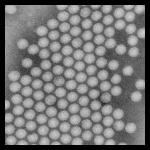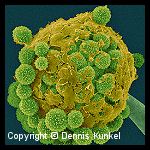Resources
Image Den

Negative stained transmission electron microscopy (TEM) image of the Poliovirus (Enterovirus C). This virus belongs to the Picornaviridae family and causes poliomyelitis also known as polio. Polio is a crippling and potentially deadly disease. It is very contagious and spreads from individual to individual infecting the brain and spinal cord causing paralysis. Most people will not show any visible symptoms but a small proportion will develop serious symptoms. Symptoms may include meningitis, paresthesia and paralysis. Children are 99% protected via vaccination which prepares the body to fight the virus. Image courtesy of the Centers for Disease Control and Prevention (CDC / Dr. Fred Murphy; J. J. Esposito).

Mucor spp., fruiting structure with spores. Magnification 400, scanning electron microscopy. The fruiting structure (condiophore) has matured and its outer membrane is disintegrating allowing the spores (conidia) to be released. Mucor is a common fungus found in many environments. It is a Zygomycetes fungus which may be allergenic and is often found as saprobes in soils, dead plant material (such as hay), horse dung, and fruits. Mucor is in house dust, air samples, and old dirty carpets, especially in water damaged moist building materials. Accumulated dust in ventilation ducts may contain high concentrations of viable Mucor spores giving rise to allergic or asthmatic reactions. It is an opportunistic pathogen and may cause mucorosis in immunocompromised individuals. The sites of infections are the lung, nasal sinus, brain, eye, and skin. Few species have been isolated from cases of zygomycosis, but the term mucormycosis has often been used. Zygomycosis includes mucocutaneous and rhinocerebral infections, as well as renal infections, gastritis, and pulmonary infections. Courtesy of Dennis Kunkel.
Featured Items
The Encyclopedia of Earth (EoE).
Bacteria are any of a very large group of single-celled microorganisms that display a wide range of metabolic types, geometric shapes and environmental habitats—and niches—of occurrence.
By Scientific American.
Microbial partnerships turn out to be more common and influential than scientists could have ever imagined.
By The Science Learning Hub.
Cold seeps are places on the seafloor where cold hydrocarbon-rich water escapes. They occur most often at tectonic plate boundaries. Carbonate deposits and communities of organisms are often found at these sites.
EMBO was established with the aim to promote molecular biology studies in Europe.
Promoting research on Epstein-Barr virus and associated diseases; it also sponsors one major international conference on EBV and associated diseases.
This bacteria is a Gram-negative, curved, rod-shaped, motile organism that causes foodborne, skin and wound infections. This organism and others of its genus live in brackish and salt water. Disease and infections occur more frequently in summer months when water temperatures are warmer. Symptoms of infection within 24 to 48 hours may include chills, fever, nausea, vomiting, diarrhea, shock and skin lesions.
